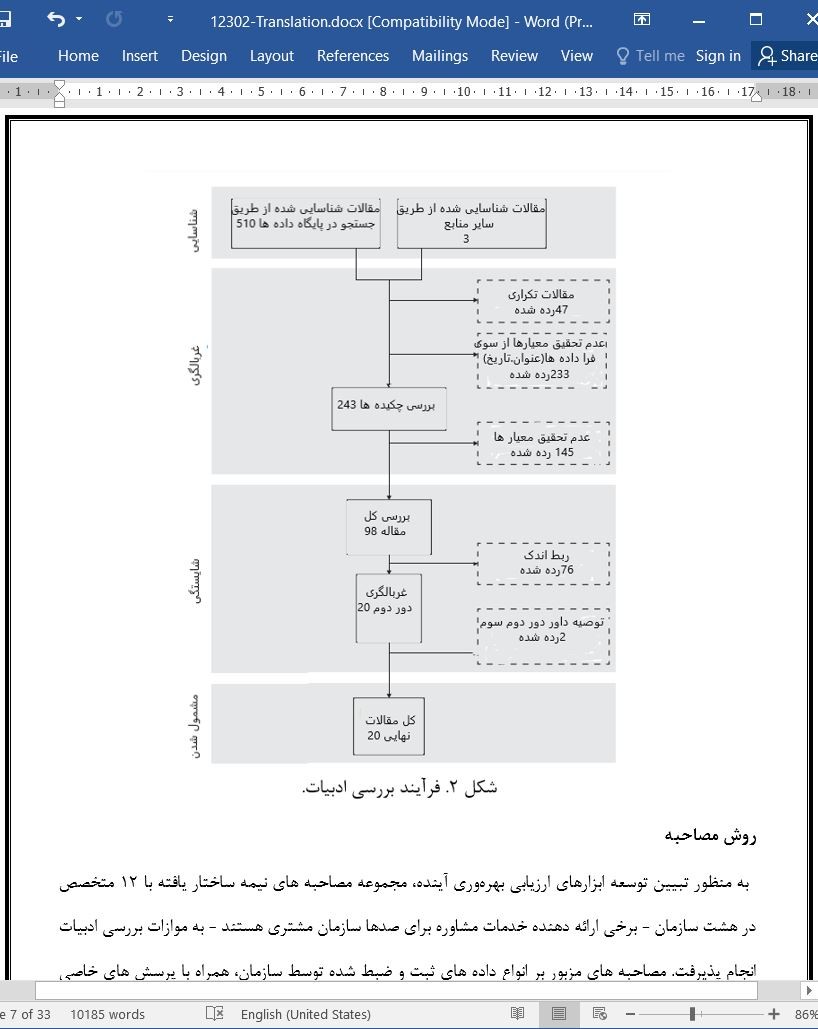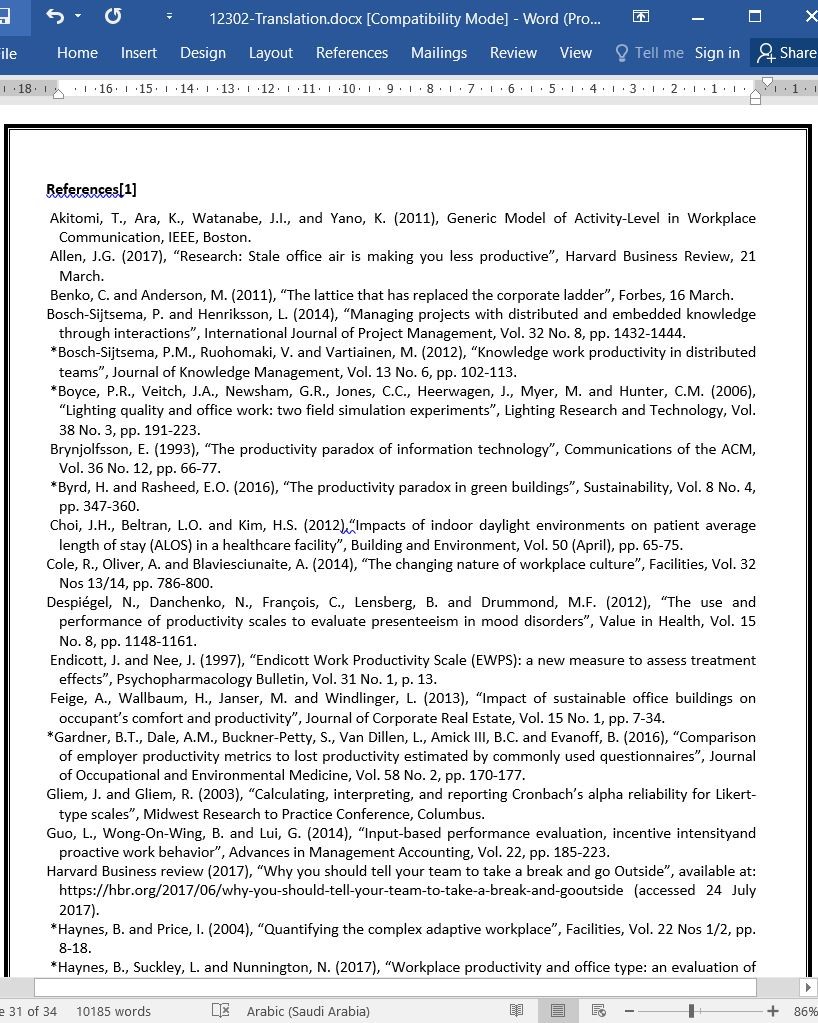
ارزیابی بهرهوری محیط کار در چارچوب اداری
چکیده
هدف - هدف مقاله حاضر ارائه نظرسنجی جامعی از شاخص های کلیدی عملکرد (KPI) بهرهوری محیط کار در چارچوب اداری است. ادبیات علمی 10 سال گذشته از طریق مجموعه مصاحبه های تخصصی به صورت نظاممند بررسی و زمینهچینی شده است.
طرح / روششناسی / رویکرد - نویسندگان به بررسی نظاممندی از ادبیات برای شناسایی KPI و روش های ارزیابی بهرهوری محیط کار پرداختند که با نکات مصاحبه های نیمه ساختار یافته تکمیل می شوند تا چارچوبی را برای ابزار الگوبرداری مهیا گردانند. در مجموع، 513 مقاله منتشر شده از سال 2007 مد نظر قرار گرفتند که از این میان 98 مقاله کامل مورد بررسی قرار گرفته و 20 مقاله نکات قابل توجهی را ارائه نمودند که در اینجا به صورت خلاصه به آن ها اشاره شده است.
یافته ها - در حال حاضر، هیچ اِجماعی درباره KPI واحد و مناسبی برای ارزیابی بهرهوری محیط کار در محیط اداری وجود ندارد، اگر چه پرسشنامه های کیفی بیشتر از ابزارهای کمّی اتخاذ شده اند. تنوع KPI مورد استفاده در مطالعات منتشره نشان می دهد که رویکرد چندبُعدی مناسب ترین روش برای ارزیابی بهرهوری دانشورزان خواهد بود. مصاحبه های تخصصی بیشتر بر گذار از ارزیابی نادر و دقیق به گزارشگری ساده و وافر در توابع مختلف منابع انسانی تاکید داشته و زمینه مذکور برای توسعه ابزار در آینده حائز اهمیت می باشد.
اصالت / ارزش - مقاله حاضر به ارائه خلاصة آثار مهم درباره ارزیابی بهرهوری محیط کار و توسعه KPI در 10 سال گذشته می پردازد. مطالعه حاضر با تبعیت از بررسی جامع بی. هینز (a2007) به ارائه دیدگاه بهروزی درباره تحقیق در این زمینه همراه با نکات دیگری از مصاحبه با متخصصان می پردازد.
مقدمه
در زمینه دانشورزان، علاقه فزاینده ای به ارتقاء بهرهوری کارکنان و تیم وجود دارد چرا که منابع انسانی بیش ترین سهم هزینه ها را تشکیل داده و بخش اعظم درآمد سازمان را ایجاد می نمایند. به رغم تحقیقات قابل توجه در رابطه با تاثیر شرایط محیطی داخلی بر بهرهوری در حوزه های آموزش و بهداشت، تحقیقات اندکی درباره ارزیابی بهرهوری در زمینه دانشورزان وجود دارد. از آخرین بررسی نظاممند درباره این موضوع (هینز، 2007)، پذیرش گسترده فناوری اطلاعات وقوع یافته که باعث افزایش میزان وقوع مهمانپذیری یا هتلینگ / میز کار گردشی یا هات دسکینگ ، ساعات انعطاف پذیر و دورکاری گشته (کول و همکاران، 2014)، و گذار به سوی محیط کار مبتنی بر فعالیت را ترغیب می نماید (ولرز و هرتل، 2017). همزمان، ورود نسل جدید به نیروی کار باعث افزایش فراوانی بازخورد شده (والدن و همکاران، 2017) و ارزیابی و مدیریت عملکرد از الگوبرداری نادر و مشخص به سوی کسب داده ها در زمان تقریباً واقعی برای اطلاع از پیشرفت مستمر تغییر یافته است. بررسی ادبیات حاضر به گفتمان جاری درباره بهرهوری محیط کار و ارائه نگرش های جدید از طریق بررسی ادبیات مربوطه و مصاحبه با متخصصان صنعتی برای ارائه دیدگاه جامع و بهروزی درباره ارزیابی بهرهوری دانشورزان می پردازد.
Abstract
Purpose – The purpose of this paper is to present a comprehensive survey of workplace productivity key performance indicators (KPIs) used in the office context. Academic literature from the past 10 years has been systematically reviewed and contextualized through a series of expert interviews.
Design/methodology/approach – The authors present a systematic review of the literature to identify KPIs and methods of workplace productivity measurement, complemented by insights semi-structured interviews to inform a framework for a benchmarking tool. In total, 513 papers published since 2007 were considered, of which 98 full-length papers were reviewed, and 20 were found to provide significant insight and are summarized herein.
Findings – Currently, no consensus exists on a single KPI suitable for measuring workplace productivity in an office environment, although qualitative questionnaires are more widely adopted than quantitative tools. The diversity of KPIs used in published studies indicates that a multidimensional approach would be the most appropriate for knowledge-worker productivity measurement. Expert interviews further highlighted a shift from infrequent, detailed evaluation to frequent, simplified reporting across human resource functions and this context is important for future tool development.
Originality/value – This paper provides a summary of significant work on workplace productivity measurement and KPI development over the past 10 years. This follows up on the comprehensive review by B. Haynes (2007a), providing an updated perspective on research in this field with additional insights from expert interviews.
Introduction
In the knowledge worker context, there is increasing interest in improving worker and team productivity, as human resources form the highest share of expenses and generate the majority of the organization’s income. Despite significant research correlating indoor environmental conditions on productivity in education and healthcare fields, there is a paucity of research on productivity measurement in the knowledge worker context. Since the last systematic review on this topic (Haynes, 2007), there has been a widespread adoption of information technology that has increased the incidence of hoteling/hot-desking, flexible hours and remote working (Cole et al., 2014), and it encouraged a shift to activity based workplaces (Wohlers and Hertel, 2017). Concurrently, the induction of millennials into the workforce has resulted in a desire for increased feedback frequency (Walden et al., 2017), shifting appraisals and other performance management from infrequent, punctuated benchmarking to near real-time data acquisition to inform continuous improvement. This literature review contributes to the ongoing discourse regarding workplace productivity, providing new insights, both from the literature and from interviews with industry experts, to provide an up-to-date holistic perspective on productivity measurement of knowledge workers.
Conclusions and implications for workplace productivity measurement
Since the review completed by Haynes (2007a), there has been a diversity of research in workplace productivity within the office context. The 20 papers reviewed have indicated a series of dominant workplace productivity KPIs and metrics. While significant future research is required to develop and test a multidimensional tool capturing these aspects, the literature review and insight from expert interviews has informed a theoretical framework for office worker productivity
چکیده
مقدمه
تعاریف
هدف تحقیق و تایید سوالات
انواع KPI و منابع داده ها
عوامل درگیر
روششناسی
روش بررسی ادبیات
روش مصاحبه
یافته های حاصل از بررسی ادبیات
شاخص های کلیدی عملکرد
عوامل نقشآفرین
عوامل در مقابل شاخص ها
زمینهچینی نتایج
مسائل پیرامون خودارزیابی
دسترس پذیری داده ها برای ارزیابی بهرهوری محیط کار
محیط کار 2.0 و فراتر از آن
نتیجه گیری ها و پیامدهای ارزیابی بهرهوری در محیط کار
منابع
Abstract
Introduction
Definitions
Research objective and supporting questions
KPI types and data sources
Contributing factors
Methodology
Literature review methodology
Interview methodology
Findings from literature
Key performance indicators
Contributing factors
Factors versus indicators
Contextualizing the results
Issues surrounding self-assessment
Availability of data for workplace productivity measurement
Workplace 2.0 and beyond
Conclusions and implications for workplace productivity measurement
References
- اصل مقاله انگلیسی با فرمت ورد (word) با قابلیت ویرایش
- ترجمه فارسی مقاله با فرمت ورد (word) با قابلیت ویرایش، بدون آرم سایت ای ترجمه
- ترجمه فارسی مقاله با فرمت pdf، بدون آرم سایت ای ترجمه



